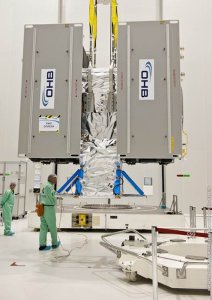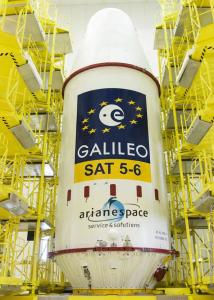Final functional testing of Galileo satellites has been completed at Europe’s Spaceport in French Guiana.
The fuelling of the two satellites, allowing them to fine-tune their orbits and maintain their altitude over the course of their 12-year lifetimes, took place on 7–8 August.
Engineers donned protective SCAPE (Self Contained Atmospheric Protective Ensemble) suits to fill the satellites with hydrazine propellant.
Then, on 11 August, the two satellites were installed together on the flight dispenser that secures them to the Soyuz launcher’s Fregat upper stage.
The follow-on installation of the stack – the two satellites plus dispenser – onto the Fregat stage was completed on 15 August , then encased within its protective launch fairing.
Today this combined upper composite was attached to the other three stages of the powerful Soyuz ST-B launcher ready to haul it up into orbit on Thursday.
Final operations for the launch will proceed early this week with a final countdown leading to a launcher liftoff scheduled for Thursday, 21 August at 14:31:14 CEST (12:31:14 UTC).
At three hours, 47 minutes and 57 seconds after liftoff, the satellites will then be deployed from their Fregat by the dispenser’s pyrotechnic separation system once their final 23 222 km altitude is reached.


